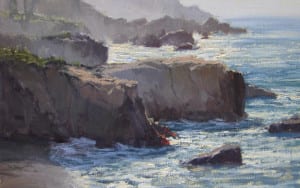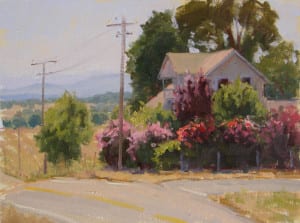
The answer is simple: no painting done from a photo can ever compare to the energy, immediacy, and sense of place that can come through in a plein air piece. Somehow the feel of the day, be it heat or cold or wind or just a perfectly pleasant morning, makes its way down the arm and off the brush and onto the canvas. I wish I knew how it happens so I could fake that quality in the studio, but that’s the magic of plein air. Our experience comes out on the canvas. All our senses help to create the painting, not just our vision. We hear the cows lowing, we feel the breeze, we smell the hay…..it’s all there on the canvas. Even my worst plein air pieces have some small element of that particular day in them. I feel like I’m recording a moment in history: it will never be July 28, 2011 at 6:00 in the morning ever again in the history of the world, but now I have a little bit of it on canvas. How exciting is that?
Not all of my paintings are completed on location, and I paint many larger works entirely in the studio. But every piece I paint has its genesis in plein air studies. Working solely from photos leaves my paintings looking flat and unexciting. I use my reference photos to jog my memory or to help me come up with better designs that I may have overlooked when I was on location. But I can’t tell you how many times I’ve discarded a studio painting because I didn’t have enough plein air information on the scene to make the painting look convincing and alive. All the answers are outside, and even the most frustrating day of plein airing brings a more acute awareness of the subtleties of painting from life. Those skills honed outside make the studio work that much easier and fun.

Oil Painting
Landscape Art

I begin by finding a site, something that I can visualize as a painting, select a focus, the remainder of the painting will be painted in relationship to the focus so as to direct the viewer to the focus or center of interest. Then I loosely arrange in my mind the elements on the painting surface, the composition.
Next I begin the painting by loosely painting in the major shapes in a linear fashion. Then I begin the masses by painting in a large known quantity, usually the sky, painting from back to front, background to foreground, thin in the shadows, thick in the light and leaving details for the last stages.
To elaborate on this process, watch the video below as I identify my location and demonstrate some of the techniques I refer to above.
//www.youtube.com/watch?feature=player_embedded&v=05Kkf-xu1bk
Style vs. Technique

An individual style, while part of the artist’s being, can contain a multitude of technical approaches and variations. Thus, technique is the systematic procedure by which the style is conveyed.
We all come into this world as human babies, yet with us, we carry the subconscious skills and memory of a million lifetimes. Parents often believe that they guide and direct their children – perhaps they do. Yet so often children display an aptitude, which is totally foreign to the abilities and ideals of the parents. Inherent subconscious abilities mingle with the new enforced dogma of pre-schooling to mold individual style or character of youth. Then, of course, there is the astrological approach. If you are a Virgo, the chances are you will become a more gentle and precise person than your brother or sister, who is a Sagittarian or Leo. These will often all but challenge life, and are more subjective, possibly less affected by the external world.
In the art world, the Sag or Leo will marvel at the patience and dedication of the Virgo, while the latter is impressed with the out of space creative ability of the former.
Essentially, all this is just words. As individuals, we have become what we have become, for better or for worse. There is little we can do about this, but we can make good use of it.
Conversely, we can discuss technique in art. Here we energize our mental faculty. We can take a shot at any technique out there. It is what each one likes, or perhaps more correctly finds easiest. One’s choice of subject matter is often governed by individual ability. For example, if one has a natural aptitude for realistic drawing, then portraits drawn or painted will be appealing.
The choice of watercolors or oils is often considered. This is definitely a technical choice. Watercolors demand a fluidity and accuracy. Then again, often the most successful watercolor is an accident.
Of oil painting, I often hear that folks like the freedom of scratching the paint off, or simply painting over the initial effort. Actually, I personally don’t buy this concept, it is just plain too messy. A good oil generally starts off clean and simply stated. It requires time to harden and is then completed.
At this point, let us revise. Style is what we are. Technique is a mental playground, it can go anywhere.
So, here is a technical suggestion. On the understanding that we love the joy of transparent watercolor on white paper, yet we are equally infatuated with the loading of impasto oils. Why not combined these two?
Loading watercolors doesn’t work too well. One tends to get a very dark image. I used to do this as a child, but this system is very extravagant and, needless to say, expensive. Adding white to those gorgeous transparent watercolors is a disaster. You might as well just buy gouache colors. But hang on; one of the greatest joys of painting is to portray life as clean and transparent. So stay with watercolors, no white pigment.
Here is the technical suggestion I spoke of earlier. Let us get back to oils. Generally, oil pigments are stipulated as transparent or opaque. For this exercise, transparent colors should be selected. No white paint or opaque colors should be on your palette. Dilute your oils with medium, and paint a very thin layer as you draw. Once you have covered the canvas, stop, and let your work dry. This may take a day or two. After both you and your painting have had a good rest, you are ready to convert your efforts to an oil impasto. Now there is no point in totally covering your transparent lay in. It was good, keep it. There is a technique known as scumbling. Using your oil pigments with as little medium as possible, or none at all, drag your new color over the transparent underlay. A course canvas texture tends to make this easier. The idea being that the visual blend of the scumble color only partly covering your transparencies will yield a vibrant effect. This effect carries twice the emotional and visual excitement of any stirred up blend of color.
So style and technique intermingle. The style is what you are born to do, the technique is what you choose to do!